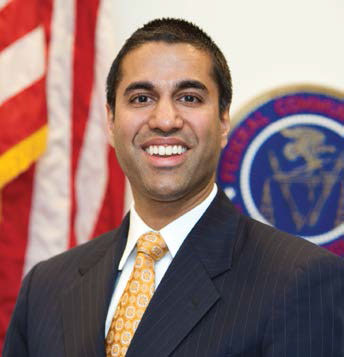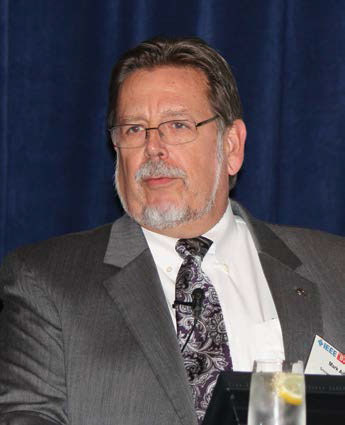Broadcasters Start Repack Process
WASHINGTON—Now the maneuvering begins, along a complicated route that runs through Washington, Wall Street and countless transmitter sites around the country as TV executives deal with the repercussions of the broadcast spectrum incentive auction. First comes the actual payout of $10 billion to broadcasters who sold 84 MHz of spectrum plus divvying up the $1.75 billion dollar fund to hundreds of stations that will actually move into repacked channel assignments.
Simultaneously, there is expected to be a significant ownership shuffle (including the “zombie channel” sidesteps), extensive fretting about the impact on FM radio stations plus an aggressive effort to convince Capitol Hill that the 39-month channel repacking timetable towards a summer 2020 deadline is not viable.
And then there’s ATSC 3.0. Although repack funds cannot be used to upgrade facilities for future services, many broadcasters want to include their 3.0 investments as they install new equipment—especially since 3.0 rules seem to be on a fast track. At the same time, wireless carriers are escalating their pressure to speed the process so they can get access to the $19.6 billion of airwaves in the 600 MHz spectrum band they just bought. (The remaining $7 billion of auction payments will go to the federal treasury for deficit reduction, an intent of the 2012 Spectrum Act legislation.) The wireless companies are also driven by technology: fifth generation (5G) systems are scheduled to come to market in 2020 (although they will more likely be used in higher bands at 3.5 GHz and above 15 GHz).
For its part, the Federal Communications Commission is expected to issue its rules and assignments (officially the “Closing and Channel Reassignment Public Notice”) for the post-auction process on April 14, predictably just before the NAB Show. Then comes a 90-day comment period. Hence much maneuvering will take place in the coming months (including at the Las Vegas convention) as details about the actual station moves take shape. Adding to the current angst is a late-March FCC decision about broadcast channel-sharing in the repack, which has raised questions about cable must-carry of stations and the role of low-power TV channels in such arrangements.
TEN-PHASE TRANSITION
The transition is scheduled to roll out in a series of 10 phases, taking into account how lighting up new channels affects nearby broadcasters. Channels in phase one may only have 18 months to move to the new assignments.

FCC Chairman Ajit Pai “Delivering on the promise of this auction will require a smooth and orderly post-auction transition,” FCC Chairman Ajit Pai said when the bidding ceased. “That means we must ensure uninterrupted access to over-the-air television and a timely clearing of the new wireless band. We will devote a great deal of attention to those tasks over the coming months, and it will be a top priority of mine as chairman of this agency.”
The battle over the 39-month timetable got a boost late last month when the National Association of Broadcasters filed a 21-page “Petition for Reconsideration,” asking the FCC to review its “flawed” framework and timeline for the repack. NAB charged that the FCC’s decisions have made “its job, and the job of the industry, considerably harder.” Specifically, the association claims that the commission “will repack far more stations than necessary and far more than can... be fully reimbursed.” NAB says the process will mean that the repack takes longer and will cause more viewer disruption.
Get the TV Tech Newsletter
The professional video industry's #1 source for news, trends and product and tech information. Sign up below.
“Under the current schedule... the commission has a very narrow window of opportunity to make corrections to the flawed transition plan the staff has developed,” NAB said. NAB has also contended that stations will need at last $2.75 billion for all repacking activities—more than $1 billion above the current allotment.
There are sympathetic ears to that argument on Capitol Hill.

Rep. Frank Pallone, Jr. “Since broadcasters can be the first line of defense during an emergency, it’s critical that viewers not lose their signals,” Rep. Frank Pallone, Jr. (D-N.J.) told TV Technology. Pallone, the ranking Democrat on the House Energy and Commerce Committee, introduced a discussion draft of “The Viewer Protection Act” last year. “Since then, I’ve received a lot of positive feedback, and with the final results of the incentive auction... it’s time for Congress to get to work on this bill.”
The proposed law would “establish an additional fund in the Treasury to reimburse broadcast television stations for costs associated with channel relocation” during the repack. It would also fund a viewer education effort to inform consumers about how to assure they receive broadcast signals after the repack and to give viewers “access to faster mobile broadband” as quickly as possible after the repack. Pallone’s goal is to “ensure that no station is forced to stop broadcasting.” Although the current draft supports the 39-month deadline, it allows wiggle room “if the broadcasters need a little more time,” according to the Committee staff.
VENDORS ARE READY
David Arland, executive director of the Indiana Broadcasters Association, voiced concern that there “is no vehicle to reimburse an FM station” for costs it may incur because of the TV repacking. In particular, Arland pointed to FM stations that lease space on TV towers and may be affected by tower changes.
He also expressed concern about the availability of tower personnel.
“If you call a tower company today, it may be six months before they show up,” Arland said. “The 39-month window may not be long enough.”
Based on his personal experience (in another capacity) during the DTV transition a decade ago, Arland warned, “It never goes as planned.”
Separately, a study funded by the Corporation for Public Broadcasting found that at least 191 CPB-eligible radio stations are colocated with a TV station that may face repacking.
Despite such concerns about the availability of equipment and construction personnel to handle the repack, some vendors acknowledge that “we’ve already started” preparations.
“We’ve added more than 54,000 square feet of manufacturing and warehouse space plus staff,” since last year’s NAB convention, according to Bill Harland, vice president of marketing for Electronics Research Inc. (ERI), one of the country’s largest tower/antenna suppliers. The Chandler, Ind.-based company now has the capacity to make 16 high-power TV antennas per month, he told TV Technology, adding that the company expects to begin deliveries by autumn.
“We’ve started preparatory work based on information that customers received in confidential letters” from the FCC, Harland said. He conceded that ERI cannot yet pursue interference studies without information about other local broadcasters, but “realistically... there are many things customers can do to get ready.” He cited “structural analysis, power information, foundation evaluation” and other site-specific preparations.
“I’m not saying it’s going to be easy, but we’ve done all we can to” meet TV stations’ needs, Harland said.
The FCC began sending confidential notifications to stations last month about their new channel assignments, so that they can begin planning. The full assignment list will be disclosed in the FCC’s mid-April Notice. At an FCC workshop in mid-March, Jean Kiddoo, deputy chair of the FCC’s Auction Task Force, suggested that stations can start broadcasting early on their post-repacking channels, but that the commission will assess the impact of such actions “on the whole transition.”

Mark Aitken, vice president of advanced technology for Sinclair Broadcast GroupSINCLAIR: PLANNING UNDERWAY
At Sinclair Broadcast Group, where 93 stations will be converted or repacked, the FCC has denoted nine stations for the first phase, according to Mark Aitken, the company’s vice president of advanced technology. He told TV Technology that Sinclair is already getting documentation and details for those nine antennas now. He expects the 10-phase process “will take a lot of coordination.”
“Space is a concern. Site surveys must be done,” Aiken said. He pointed to plumbing, HVAC, electrical distribution, insurance indemnification and other factors that must be evaluated. “That list goes wide and deep.” Moreover, some of the oldest transmitters no longer have technical support, he said, adding to the complexity of making replacement decisions. Moreover, many sites are shared with other broadcasters, further complicating the process, Aitken added. He also pointed out factors such as determining whether a tower meets or must be upgraded to G wind-load standards.
“We’re taking an aggressive position to build out early when we can distribute resources,” he said. “Some sites may be soft channel changes. We’ll build a new transmitter and operate on today’s channel then later we may gracefully rechannelize it to the new channel rather than doing a hot switches at the end.”
STATION SALES BEGIN
The auction aftermath coincides with many market and regulatory conditions that will inevitably intermesh with unknown results. For example, ownership caps—currently under reconsideration—may affect some deal-making. In particular, changes to the “UHF discount,” which deliberately under-weights high-band channels, could have an impact on groups being able to buy more stations, said Howard Liberman, a communications attorney at Wilkinson Barker Knauer LLP. He also pointed out that the repack expense will hit especially hard at stations in smaller markets, and that there will be additional challenges for LPTV stations and translators, which will not be reimbursed from the auction fund.
His WBK partner David Oxenford, who works directly with many local broadcasters, noted that the expected spurt in transactions may “have nothing to do with the auction” but expects many deals will “be driven by auction results.”
“Until you know the repacking details, it’s difficult to plan coherently” for post-auction actions, Oxenford told TV Technology. He also cited the problems for FM stations, especially if their antennas are located aboard TV towers, which may affect transmission while installers are at work and also which could change the wind-loading on the tower.
Among the near-term uncertainties is the fate of so-called “zombie channels”—broadcasters who sold spectrum but still have their broadcast licenses. Some are seeking to sell remaining assets while others may buy available stations or make channel-sharing arrangements in their communities.
Channel-sharing options, endorsed by the FCC’s latest Report and Order, allow stations with an auction-related channel-sharing agreement (CSA) to extend such relationships after the transition. The new rule also lets LPTV and translators share a channel with a full-power or Class A station.
Ari Meltzer, an attorney at the Wiley Rein law firm, focused on “the public interest benefits of applying a flexible approach to post-auction channel-sharing.”
“It would be illogical and inconsistent with this principle to say that a station can hold a license with no spectrum rights, but cannot transfer it,” Meltzer said in a published report. This approach “allows the commission to repurpose spectrum while still preserving diversity and competition on the airwaves.”
Meltzer also noted that there is no precedent for channel-sharing prices, and he pointed out that after the repacking rules are finalized—possibly by July—stations will have as little as 120 days to file their post-auction channel sharing details at the FCC.

Pat LaPlatney, president and CEO of Raycom MediaPREPARING FOR ATSC 3.0
At a Senate Commerce Committee hearing on the “Value of Spectrum” last month, Raycom Media President and CEO Pat LaPlatney, testifying on behalf of NAB, emphasized the connection between the auction and the looming “NextGen TV” plans as enunciated in the FCC’s current ATSC 3.0 deliberation.
“As the auction winds its way to completion, one thing is certain: The broadcast industry will end up with less spectrum,” LaPlatney said. He emphasized that ATSC 3.0 will not only deliver better video, but it will also enable broadcasters to deliver “more and better emergency services... [and] mobile access” and integrated broadcast/broadband content. His message was that the auction aftermath is closely connected to the introduction of Next-Gen TV services.
Sinclair’s Aitken offered a similar connection between the two developments.
“When you’re doing your engineering [for the repack], you have to have an eye toward Next-Gen TV,” he said. “For example, in the mobile portable environment, having a vertical component in the antenna’s radiation characteristics is important. Many antennas have circular or elliptical polarization.” He added that the extra cost that broadcasters would incur (beyond the FCC repack allotment) to add vertical polarization is less than a 15 percent increment and is worth it for future services.
“There must be a clear delineation of what’s authorized [for repack] vs. what I spend to prepare for 3.0,” Aitken said. He believes many broadcasters will also do such upgrades as they repack. “It would be short-sighted—maybe even irresponsible—if you’re going to implement 3.0” not to upgrade at the same time.
Dennis Wharton, NAB’s executive vice president of communications, also acknowledged the FCC’s intent to allow broadcasters to deploy ATSC 3.0 on a voluntary basis.
“If we do get approval by the end of the year, we expect that repacking and initial Next-Gen deployments can overlap, which is great for consumers because they are less likely to need to rescan their television sets multiple times to continue receiving over-the-air TV,” Wharton told TV Technology.
Wharton also characterized the FCC’s post-auction agenda as “a most significant challenge” because “no one has ever attempted this.”
“The number of repacked television stations, the complex interference relationships between those stations, resource constraints and implications for non-repacked broadcasters, including FM radio, will make this the most complex transition the FCC has ever overseen,” he said. “While the specific challenges faced by each broadcaster and in each market will be unique, we expect that repacking will be a nationwide challenge.”
Gary Arlen, a contributor to Broadcasting & Cable, NextTV and TV Tech, is known for his visionary insights into the convergence of media + telecom + content + technology. His perspectives on public/tech policy, marketing and audience measurement have added to the value of his research and analyses of emerging interactive and broadband services. Gary was founder/editor/publisher of Interactivity Report, TeleServices Report and other influential newsletters; he was the long-time “curmudgeon” columnist for Multichannel News as well as a regular contributor to AdMap, Washington Technology and Telecommunications Reports; Gary writes regularly about trends and media/marketing for the Consumer Technology Association's i3 magazine plus several blogs.

